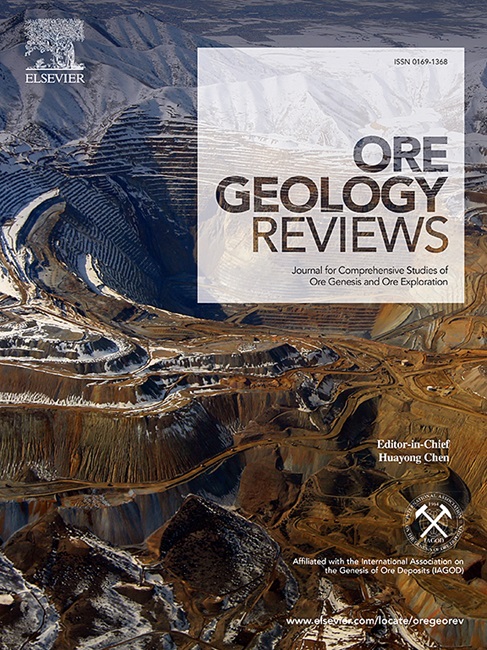Major and trace element geochemistry of garnets from the Geumseong Mo skarn deposit, South Korea: Genesis and exploration implications
IF 3.2
2区 地球科学
Q1 GEOLOGY
引用次数: 0
Abstract
Few studies have focused on analyzing the compositional variations of trace elements in garnets from Mo skarn deposits to provide their genetic implication and inform potential applications for both distinguishing skarn types and mineral exploration. To achieve this, laser ablation inductively coupled plasma mass spectrometry (LA-ICP-MS), in conjunction with electron probe microanalysis and sulfur isotope analysis, was employed to the Geumseong Mo skarn deposit located within the Hwanggangri mineralized district of South Korea. The garnets in the skarn were divided into early-formed isotropic dark red (Grt Ia) and light red (Grt Ib) garnets, and later-formed zoned red brown garnets (Grt II). These garnets were found to be replaced by molybdenite and pyrrhotite, respectively. The analysis revealed that Grt Ia and Grt Ib comprise a narrow compositional range, with Gro50–75Adr8–34 and Gro66–89Adr5–28, respectively. They exhibit positive slopes for light rare earth element (LREE), and variable Eu anomalies and heavy rare earth element (HREE) patterns. On the other hand, Grt II demonstrates a wider range of Gro3–71Adr20–96 with increased LREE/HREE ratios compared to Grt Ia and Ib, along with distinct positive Eu anomalies. Moreover, there was a systematic decrease in U concentrations as well as Eu anomalies from the core to the rim in Grt II. The observation suggests that early garnets likely formed under near-neutral pH conditions, while later garnets precipitated under mildly acidic conditions. Sulfur isotope values of sulfides including molybdenite, pyrite, pyrrhotite, and sphalerite give relatively elevated δ34S values, ranging from 10.7 to 13.4 ‰ (avg. 12.4 ‰, n = 10). The sulfur isotope characteristics suggests a significant contribution of sulfur from carbonate host rocks and an isotope disequilibrium under high fluid–rock interactions. The textural and compositional evidence indicates that Grt Ia and Grt Ib were formed under stable conditions through diffusive metasomatism via a fluid system in equilibrium with the host rocks. Conversely, the formation of Grt II appears to have occurred under variable physicochemical conditions with intermittent fluid infiltration. Discrimination diagrams for trace elements demonstrate that the Mo skarn compositional field largely overlaps with the Cu field but is distinct from the W and W-Mo fields. The finding implies that the composition of trace elements in garnet can be utilized to discriminate Mo skarn deposits from other types of skarn mineralization, and thus could be potentially applied to the exploration of Mo skarn deposits.

很少有研究侧重于分析钼矽卡岩矿床石榴石中微量元素的组成变化,以提供其遗传学意义,并为区分矽卡岩类型和矿物勘探的潜在应用提供信息。为此,我们对位于韩国黄江里矿化区的金城钼矽卡岩矿床采用了激光烧蚀电感耦合等离子体质谱法(LA-ICP-MS),并结合电子探针显微分析和硫同位素分析。矽卡岩中的石榴石分为早期形成的各向同性深红色(Grt Ia)和浅红色(Grt Ib)石榴石,以及后期形成的带状红褐色石榴石(Grt II)。这些石榴石分别被辉钼矿和黄铁矿所取代。分析表明,Grt Ia 和 Grt Ib 的成分范围较窄,分别为 Gro50-75Adr8-34 和 Gro66-89Adr5-28。它们表现出轻稀土元素(LREE)的正斜率,以及不同的 Eu 异常和重稀土元素(HREE)模式。另一方面,与 Grt Ia 和 Ib 相比,Grt II 显示出更宽的 Gro3-71Adr20-96 范围,LREE/HREE 比值增加,并伴有明显的正 Eu 异常。此外,在 Grt II 中,U 浓度和 Eu 异常值从岩心到岩缘呈系统性下降。这一观察结果表明,早期的石榴石很可能是在接近中性的pH值条件下形成的,而后期的石榴石则是在微酸性条件下沉淀的。硫化物(包括辉钼矿、黄铁矿、黄铁矿和闪锌矿)的硫同位素值给出了相对较高的δ34S 值,范围在 10.7 至 13.4 ‰ 之间(平均值为 12.4 ‰,n = 10)。硫同位素特征表明,碳酸盐主岩的硫含量很高,而且在流体与岩石的高度相互作用下存在同位素不平衡现象。纹理和成分证据表明,Grt Ia 和 Grt Ib 是在稳定条件下通过与寄主岩平衡的流体系统扩散变质作用形成的。相反,Grt II 的形成似乎是在间歇性流体渗入的多变物理化学条件下发生的。痕量元素的判别图显示,钼矽卡岩成分场在很大程度上与铜场重叠,但与钨场和钼场不同。这一发现意味着,可以利用石榴石中的微量元素组成来区分矽卡岩钼矿床和其他类型的矽卡岩矿化,从而有可能应用于矽卡岩钼矿床的勘探。
本文章由计算机程序翻译,如有差异,请以英文原文为准。
求助全文
约1分钟内获得全文
求助全文
来源期刊

Ore Geology Reviews
地学-地质学
CiteScore
6.50
自引率
27.30%
发文量
546
审稿时长
22.9 weeks
期刊介绍:
Ore Geology Reviews aims to familiarize all earth scientists with recent advances in a number of interconnected disciplines related to the study of, and search for, ore deposits. The reviews range from brief to longer contributions, but the journal preferentially publishes manuscripts that fill the niche between the commonly shorter journal articles and the comprehensive book coverages, and thus has a special appeal to many authors and readers.
 求助内容:
求助内容: 应助结果提醒方式:
应助结果提醒方式:


